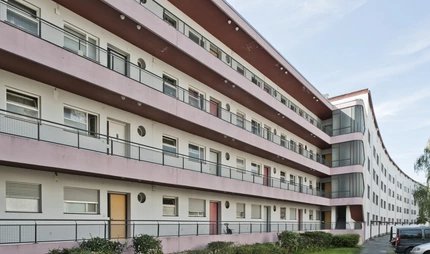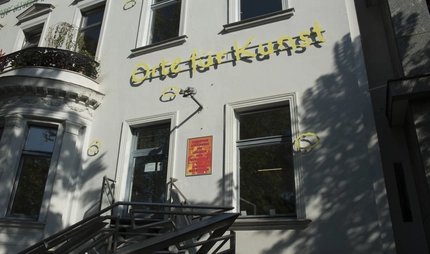
The 1920s – Architecture in Berlin
In the 1920s, Berlin becomes the birthplace of the influential Bauhaus movement in art, design and architecture. Architecture in Berlin is defined by its revolutionary, all-embracing aesthetic, perhaps more than any other. Reacting against the industrial context that shaped turn of the century lives, the movement instead prioritised an ergonomic unity of function and form. Although the movement is derailed (and disseminated) by the National Socialist party, and further damaged by World War 2 blasts, many original 1920s buildings managed to survive and still stand in Berlin today. Meanwhile, the reverberations of the revolutionary architechtural movements during this time are still felt across the world.
Architecture in Berlin is forever linked with the city's identity as an important generator of new forms of social life. From the World Heritage protected social housing of the '20s to German Democratic Republic (GDR) era Plattenbauten and the squatters movement of the 1970s and '80s, architecture – residential in particular – has remained a locus of both urban and societal transformation. Arising from the German Empire's industrial architecture and its dearth of space and light, 1920s modernism seeks to redefine the shape of society along more holistic lines. Despite the ravages of the Second World War and the GDR, you can still clearly see vestiges of its intensely innovative aesthetic in the city today.
Bauhaus literally means 'school of building', and is founded by Walter Gropius in 1919. The objective of the movement is to establish a 'total' work of art that encompasses all the arts, including architecture, and brings them into unity with one another. It is perhaps this very inclusively that determines the extent of the Bauhaus movement's far-reaching influence, which stretches around the world and alters the course of social history. The school undergoes multiple changes in leadership and emphasis before being closed by the Nazis in 1933. The closure of the school only serves to spread the movement's precepts though, as its exponents migrate across the globe. Its latter directors, Hannes Meyer and Ludwig Mies van der Rohe, both contribute to the movement's evolution and cement its subsequent influence abroad, and across diverse disciplines spanning typography, interior and graphic design.
Designed by Emil Fahrenkamp, the Shell-Haus is a piece of modernist architecture that captures the spirit of the 1920s architecture movement in Berlin. The building overlooks the Landwehrkanal in Berlin's leafy Tiergarten district. Its construction begins as a competition between five architects, each hoping to build a modern office space for the Dutch oil company Rhenania-Ossag. Fahrenkamp won the competition and two years later the Shell-Haus is built. It's opened in 1932 and is praised for its futuristic waved facade and becomes one of the most significant architectural designs of the Weimar Republic. The Shell-Haus is used as a hospital throughout WWII and despite being lightly bombed, the building is one of the few that came out of the Battle of Berlin relatively unscathed. Renovation on the Shell-Haus is completed in 2000 and today the building stands with much of the former glory as it did when it was completed in 1932.
It's hard to ignore the impressive 1920s architecture around Rosa-Luxemberg-Platz. Dominated by the imposing Volksbühne (People's Theatre), the area was a result of redevelopment to connect the important roads of Prenzlauer Berg and Mitte, to connect the East and West of the city. In 1927, architect Hans Poelzig repaired the damage caused by WWI and plans the redesign of the square, reflecting the political nature of the time with the names he chose for its streets and buildings. Poelzig is one of the lesser known names in modernism and New Objectivity, but his importance cannot be understated. Much of Poelzig's contribution to Berlin's architecture was destroyed during the second World War, either by bombing or by the National Socialists themselves, who preferred a more brutalist style of architecture. One of the two surviving contributions of Poelzig's original plan for Rosa-Luxemberg-Platz is the Babylon Kino, which stands out for its curved facade. The Haus des Rundfunk if another of Poelzig's surviving master works. The enormous structure is completed in 1931 and is designed with acoustics in mind, and is still used as a functioning broadcasting house today.
The pervasive influence of Bauhaus is perhaps to blame for the common misconception that the movement is also responsible for the social housing constructed in Berlin during the Weimar era. The influence of the contemporaneous ideas of the Bauhaus is apparent in the design of six UNESCO World Heritage protected modernist estates in the city. Exemplary of a bright and air-filled aesthetic, these estates survive the war, and remain some of the city's most desirable real estate. Evidence of Bauhaus' influence is discernible in the spectacular modernist estates throughout the city. Housing constructed by Bruno Taut, close to the U-Bahn stop Onkel Toms Hütte for instance, still serves its original residential function. When you visit Berlin, look out for the lineaments of Bauhaus that continue to define the face of the city today.



